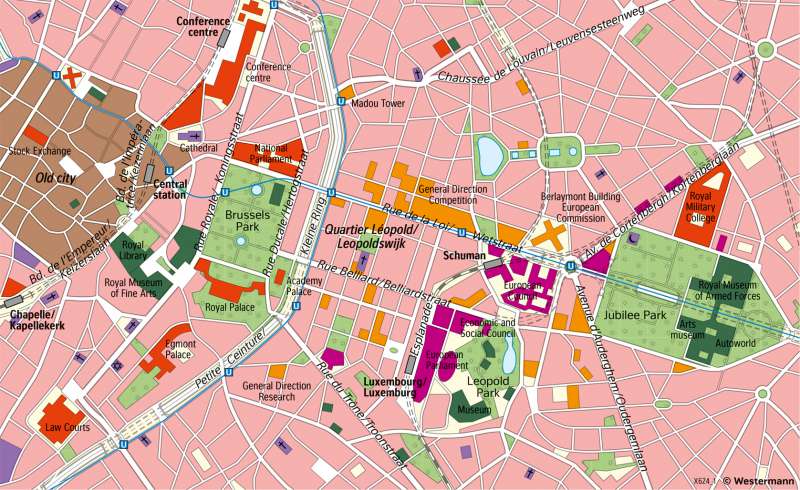Brussels - EU headquarters
European Union
978-3-14-100890-6 | Page 66 | Ill. 3

Overview
The capital and seat of the ruling house of the Kingdom of Belgium is embedded in the Brussels Basin between the lowlands of Flanders and the Brabant Plateau. The administrative district of the city has only 180,000 inhabitants. With an area of 162 square kilometres, the capital region expanded into a metropolis through the incorporation of 18 other, largely autonomous communities. Numerous international organisations and institutions have established their headquarters in Brussels.
The European Quarter
The map shows the district known as the European Quarter, in which the majority of European political and administrative institutions are concentrated. It is separated by the eastern section of the Avenue des Arts, the inner-urban ring road, from the historical city centre and the government district, which is home to the National Parliament, the Royal Palace, the Royal Library, and the Palace of the Fine Arts, among other institutions. The European Quarter is bordered to the east by the Jubilee Park (Parc du Cinquantenaire). The park was built on former exercise grounds outside the city centre in honour of the 50th anniversary of Belgium's independence in 1880. Today, one of Brussels' main traffic arteries runs through the 37-hectare park. The Arch of Triumph with its quadriga was opened at the east entrance to the park in 1905. The long buildings on each side of the arch now house the Military and Automobile Museum. In 1958, the year of the World Exposition, Brussels became the seat of the European Economic Community, the predecessor of the European Union. NATO moved its headquarters from Paris to Brussels in 1967. The process of redesigning the old Leopold Quarter with its many art nouveau mansions into a progressively growing "Cité Européene" full of modern administrative palaces began with the cross-shaped Berlaymont Building, the seat of the European Commission, in the 1960s. The Council of Ministers of the European Union meets across the street from the European Commission. The meetings of the European Council are held in the new Résidence Palace. The new European Parliament building, a complex structure composed of glass, steel and concrete, stands between the Place de Luxembourg and the Leopoldpark. In addition to the many administrative agencies and institutions of the European Union, numerous special-interest groups, lobbyists and multinational corporations have established offices near the European decision-making bodies. The resulting rapid rise in the demand for office space has forced the resident population to move to the outer fringes of Brussels.
Other Cities of Europe
Brussels is not the only "City of Europe". Luxembourg is home to the Secretary General of the European Parliament, the European Court of Justice, the European Court of Auditors and the European Investment Bank. The Council of Europe is located in Strasbourg, which is also the seat of the European Parliament, where twelve monthly sessions are scheduled each year.




